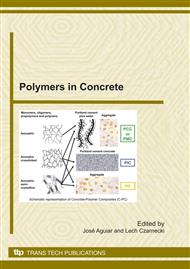p.29
p.37
p.47
p.57
p.65
p.73
p.85
p.97
p.105
Effect of Epoxy Resin Addition on the Moisture Sensitivity of Macro Defect Free Polymer-Cement Composites
Abstract:
Macro-defect-free (MDF) cements are cement-polymer composites and were developed by Birchall et al. three decades ago. The composites are produced by mixing small amounts of polymer and water with cement. However, they have a different production method than that of cement pastes, which was inspired by rubber production. Mixtures of cement, polymer and water are processed by using a two-roll mill. The composites are known with their high flexural strengths. Unfortunately, there are not any known commercial products using MDF cements because of their poor durability under moisture. In this study, MDF cements were prepared by using poly(vinyl alcohol--vinyl acetate) PVA, calcium aluminate cements and two different types of epoxy resins. Epoxy resins were a diglycidyl ether of bisphenol A and a mixture of a diglycidyl ethers of bisphenol A and F. Durability performance was compared with respect to biaxial flexural strengths, contact angle and atomic force microscopy (AFM) for the specimens stored in water.
Info:
Periodical:
Pages:
65-72
Citation:
Online since:
January 2011
Keywords:
Price:
Сopyright:
© 2011 Trans Tech Publications Ltd. All Rights Reserved
Share:
Citation:


